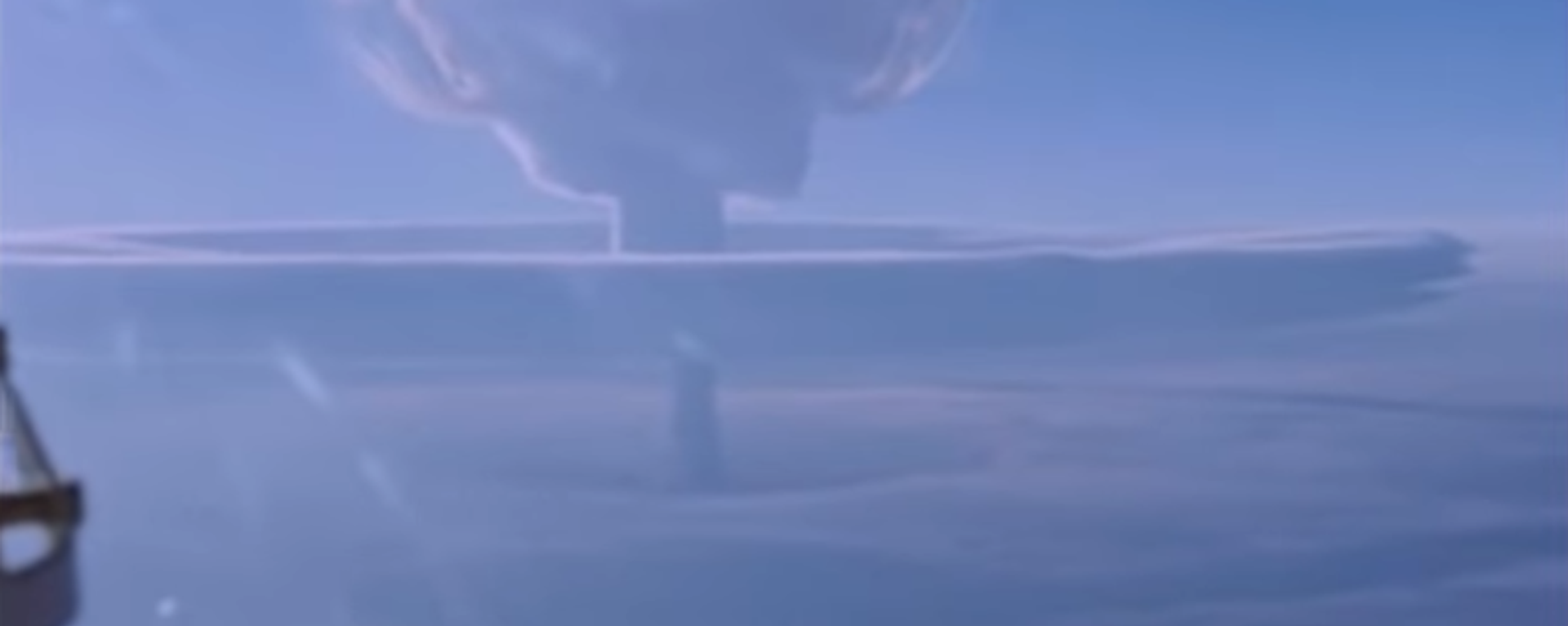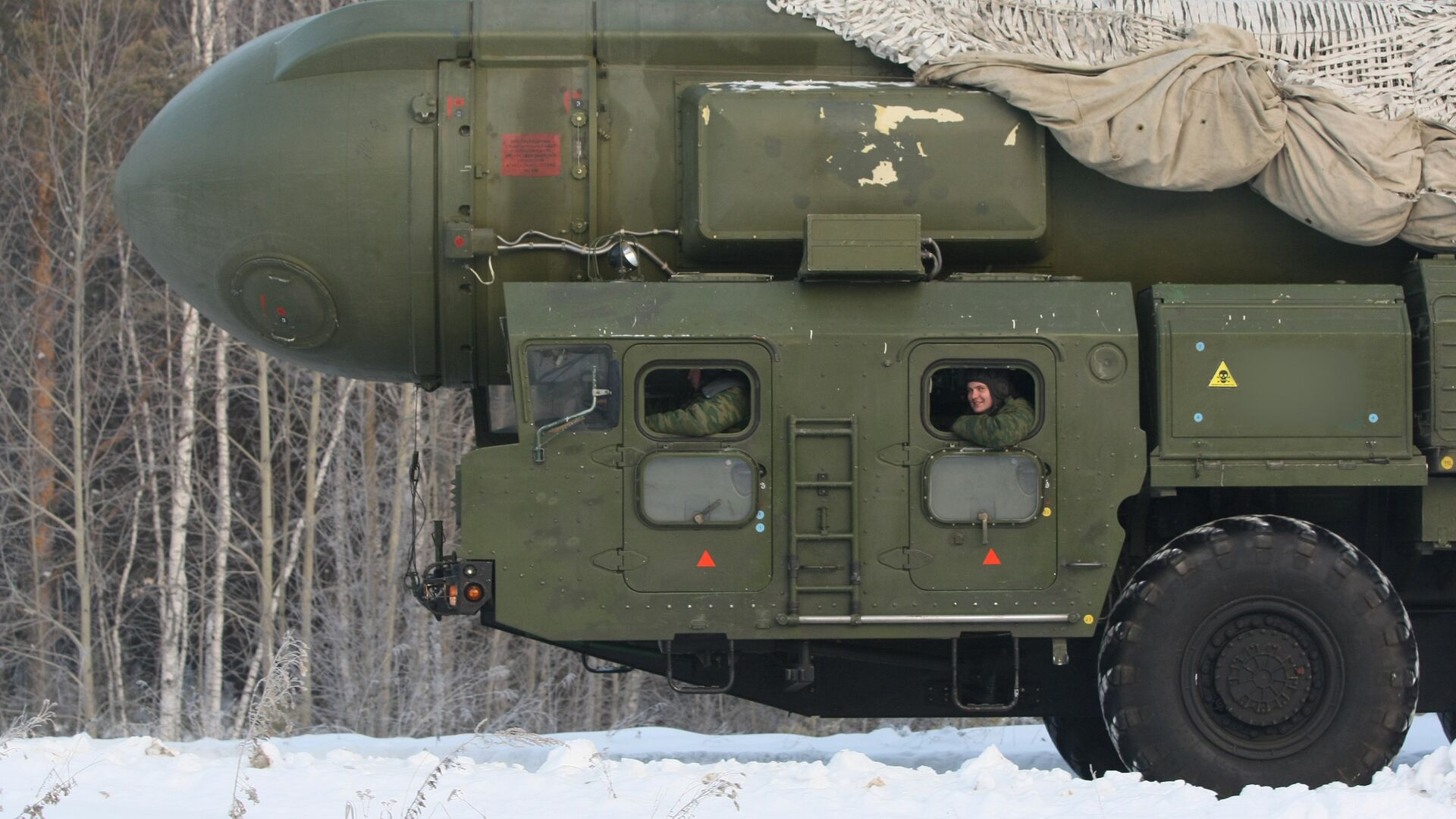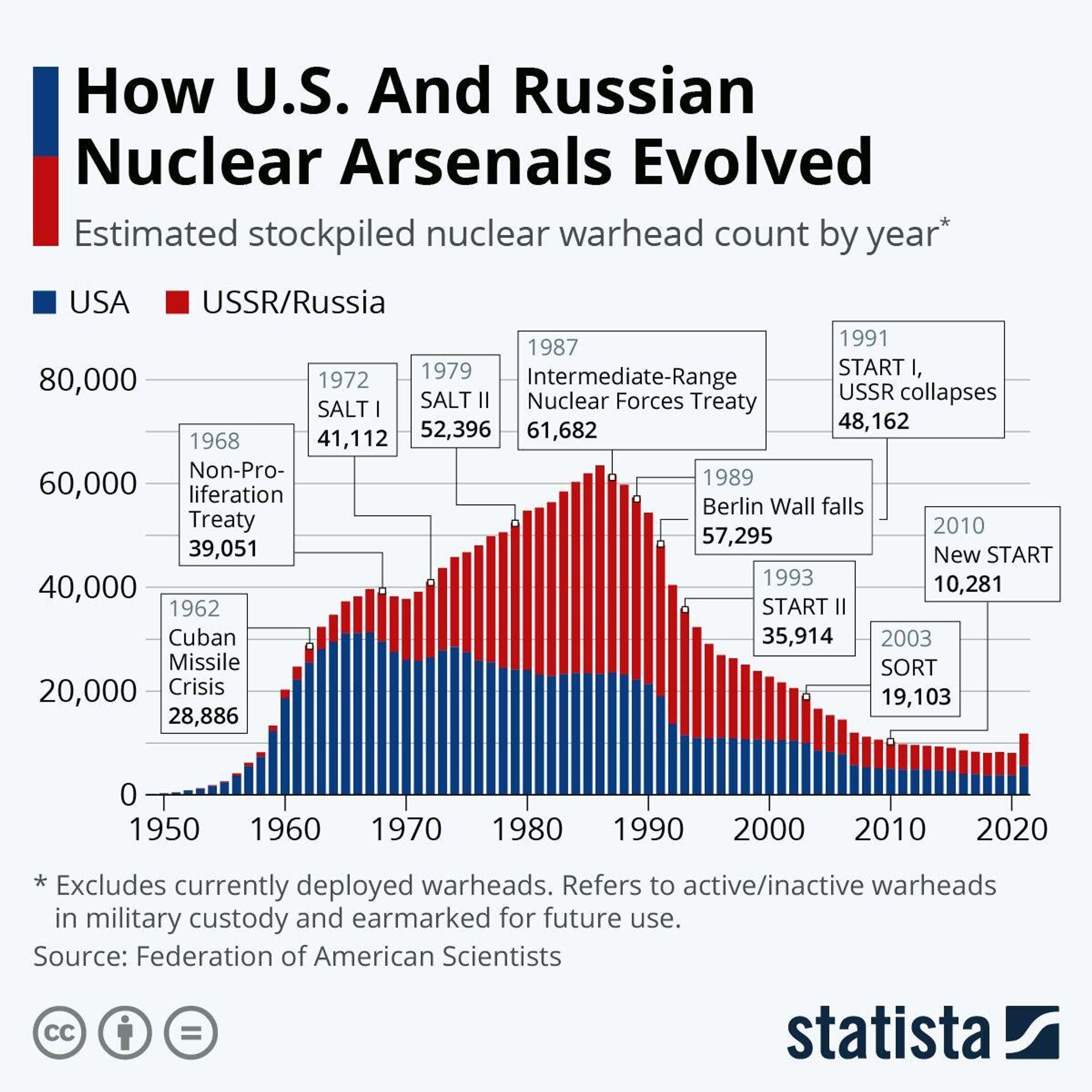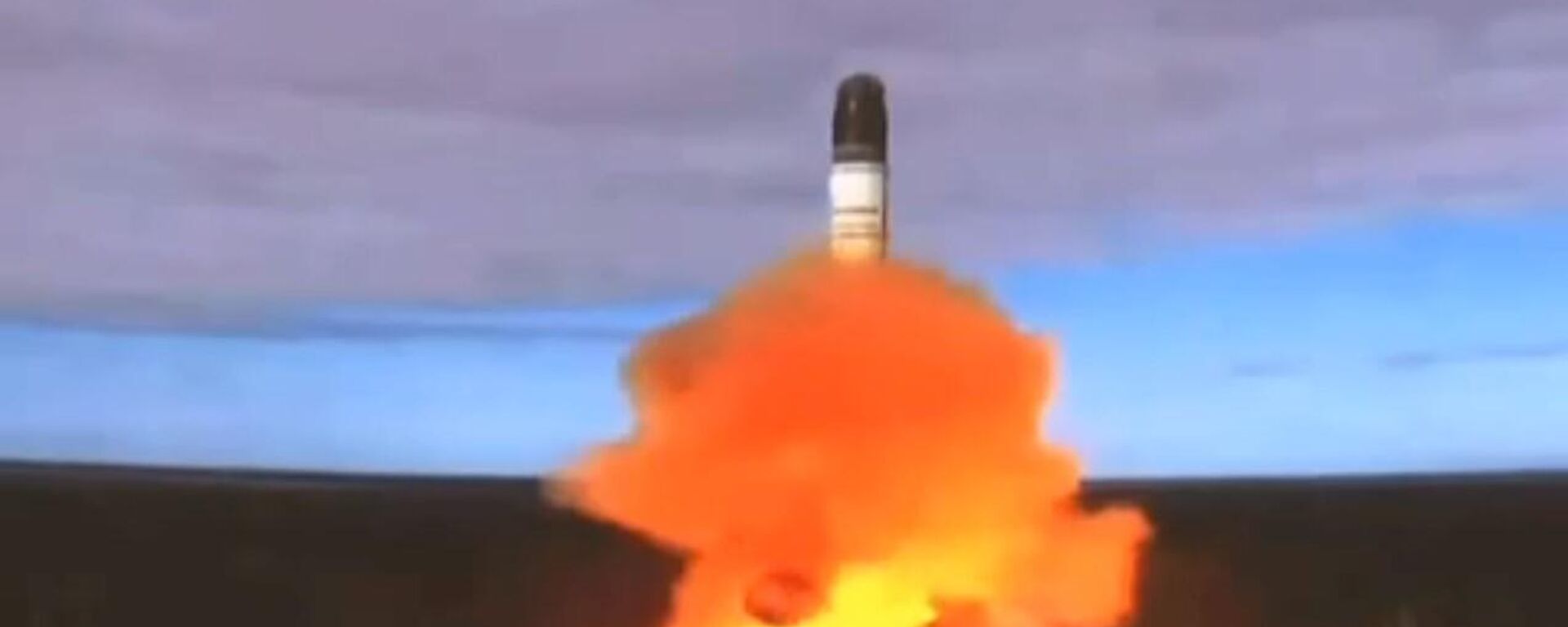https://sputnikglobe.com/20230411/how-many-nukes-does-russia-have-in-2023-and-what-kinds-are-there-1107385137.html
How Many Nukes Does Russia Have in 2023, and What Kinds are There?
How Many Nukes Does Russia Have in 2023, and What Kinds are There?
Sputnik International
How many nukes does Moscow have in its arsenal in 2023? Under what conditions could it would use them? Sputnik explains.
2023-04-11T10:39+0000
2023-04-11T10:39+0000
2023-07-31T16:51+0000
military
missile
nuclear weapons
strategic nuclear weapons
treaty on the non-proliferation of nuclear weapons (npt)
us nukes
nuclear
nuclear war
nuclear non-proliferation
russia
https://cdn1.img.sputnikglobe.com/img/106007/22/1060072204_0:160:3073:1888_1920x0_80_0_0_0fcaf93a5c8778c580351fe0127e4eb4.jpg
The number of alarmist, outright Goebbels-esque stories in the mainstream press about Russia planning to use nuclear weapons in Ukraine has dropped dramatically since peak paranoia and fearmongering were reached last October, when media and governments urged the public to actively prepare for a nuclear war through a bizarre 21st century version of duck-and-cover.In February, the official journal of the Council on Foreign Relations – a highly influential US-based foreign policy think tank, urged officials to avoid poking the Russian bear by giving Moscow the impression that a direct conflict with NATO over Ukraine was inevitable. Instead, the journal suggested, the West should use “calibrated deterring communication and military maneuvers that cannot be misinterpreted as preparations for an operation against Russia.”Whether the White House and NATO are actually prepared to listen to this advice is another story. After former Russian president Dmitry Medvedev warned that a nuclear power cannot lose a conventional conflict on which its fate depends without a conventional conflict potentially going nuclear, US officials and intelligence analysts confidently assured that the danger of a nuclear escalation is under their control and that they are gradually 'getting a feel for' Russia’s red lines.President Putin announced in February that Russia would be suspending its participation in the New Strategic Arms Reduction Treaty, citing US efforts to "inflict a strategic defeat" on Russia and help Ukraine launch drone strikes against bases containing Russia's strategic deterrent while "absurdly" calling for more inspections and the separation of the deterrence issue from the Ukrainian crisis.What Countries are in the Nuclear Club in 2023?Since the first-ever nuclear weapons test in July 1945 and physicist Robert Oppenheimer’s famous evocation of the Bhagavad Gita line “now I am become Death, the destroyer of worlds,” nine countries have become part of the nuclear weapons club - the United States, Russia, Britain, France, China, Israel (allegedly), India, Pakistan, and North Korea. Some 25 other countries have accessed or are close to accessing nuclear power for peaceful purposes, putting them a few theoretical steps from the bomb. However, membership in the Non-Proliferation Treaty forbids the latter nations from pursuing a nuclear weapon.Which Country Has the Biggest Nuclear Arsenal?With a total arsenal of 5,977 deployed, stored or stockpiled nukes, Russia has the largest nuclear arsenal in the world, with its nuclear weapons accounting for about 47 percent of the world total of 12,700 total nukes. About 1,590 of these weapons are deployed and ready to be fired via ballistic and cruise missiles.How are Russia's Nukes Divided?Russia’s nuclear weapons arsenal is divided between the ground-based Strategic Rocket Forces, the Navy’s Strategic Forces and Strategic Aviation. The missile troops account for about 47 of the total, while the naval component accounts for 33 percent, and air power for the remaining 20 percent. The division of Russia’s nuclear arsenal into three separate components provides the country with a higher sense of strategic security than it would have if it had just one or two delivery means. But more on that below.How Many Tsar Bombs Does Russia Have?In October 1961, the USSR detonated the Tsar Bomba – the most powerful nuclear weapon ever made and tested. After being dropped from a Tu-95V ‘Bear’ bomber over the Russian Arctic’s Novaya Zemla Island, the Tsar Bomba generated an explosion equivalent to some 58.6 megatons of TNT (an inconceivable 1,500 times the power of the American bombs dropped on Hiroshima and Nagasaki in August 1945). Unlike those weapons, which killed up to 226,000 people, the Tsar Bomba isn’t known to have killed or injured any people, and was detonated high enough in the air (4 km) to prevent local flora and fauna from being absolutely decimated.Although the Tsar Bomba was never built into a series production nuclear weapon, it continues to spark a crude and morbid fascination among scientists and internet users, with Google searches like ‘how many Tsar Bombs does Russia have’ and maps of the Tsar Bomba’s blast radius superimposed on various cities evoking interest more than 60 years since the test took place.Modern nuclear weapons have a TNT equivalent yield significantly below that of the Tsar Bomba, with Russia’s Sarmat intercontinental ballistic missile’s ten multiple independent reentry vehicles (MIRVs) featuring a total blast yield of about 7.5 megatons, while the US’s Minuteman III series missiles’ three MIRVs carry a destructive power of between 335 and 475 kilotons.Why Does Russia Have Such a Large Nuclear Arsenal?Russia has about 550 nuclear warheads more than the United States, which with 5,428 weapons has the second-largest arsenal in the world. The nuclear superpowers have gradually chipped away at the size of their nuclear arsenals since the late 1980s, bringing totals down from over 61,000 in the mid-1980s to 48,162 with the signing of the Strategic Arms Reduction Treaty I in 1991, 35,914 with START II in 1993, and 10,281 with New START in 2010 (which was renewed for five years in 2021).Russia’s larger nuclear arsenal allows it to compensate for its weaker conventional capabilities vis-à-vis the combined power of the United States and NATO, basically flipping the script of the old Cold War-era balance of power in Europe between the Western Bloc and the Soviet-led Warsaw Pact.At the moment, Russia’s nuclear doctrine forbids the preemptive use of nuclear weapons, with the fearsome weapons deemed “exclusively as a means of deterrence, their use being an extreme and compelled measure.” Late last year, President Putin publicly floated the idea of altering the nuclear doctrine to a US-style one, which has no limits on first strike attacks. However, no official updates to the Russian nuclear doctrine have been published since.What is the Range of Russia's Nukes and How Far Can They Travel?Russia's nuclear deterrent includes a variety of delivery systems, among them submarine-launched Bulava missiles, which have a range of up to 10,000 km, and ground-based R-36 intercontinental ballistic missiles, with a range of up to 16,000 km. Russia has also developed the Burevestnik, an experimental nuclear-powered, nuclear-armed cruise missiles with effectively an unlimited range.Can Russia’s Nukes Reach the US? Can They Be Stopped by US Missile Defense?With this in mind, Russian military planners have a series of means with which to deliver nukes to targets inside the US, including ICBMs with a range of up to 18,000 km, missiles launched by impossible to track submarines, and air launched nuclear cruise missiles. The nuclear triad, complemented by a new generation of strategic weapons like autonomous nuclear-powered and nuclear-armed torpedoes, Kinzhal nuclear-capable hypersonic missiles and Avangard hypersonic glide vehicles, is designed to ensure that even if an adversary caught Russia off-guard in a nuclear or conventional first strike, the response would be so severe that enemy planners have to think twice before launching such aggression.This modern-day ‘balance of terror’, also known as the ‘mutually ensured destruction’ doctrine, has been a hallmark of the strategic balance between the nuclear superpowers since the 1960s. And while it’s terrifying to think about, it’s also thought to be one of the main reasons there hasn’t been another World War after 1945.
https://sputnikglobe.com/20221112/what-kind-of-missiles-does-north-korea-launch-1104048334.html
https://sputnikglobe.com/20220424/russias-sarmat-icbm-could-be-deployed-with-several-avangard-hypersonic-glide-vehicles-1095016959.html
https://sputnikglobe.com/20200824/video-russias-rosatom-releases-new-footage-of-tsar-bomba-worlds-most-powerful-nuclear-bomb-1080266347.html
https://sputnikglobe.com/20221028/ex-dod-officer-us-hypersonic-race-with-russia--china-wont-save-the-day-peace-talks-are-a-must-1102802409.html
russia
Sputnik International
feedback@sputniknews.com
+74956456601
MIA „Rosiya Segodnya“
2023
News
en_EN
Sputnik International
feedback@sputniknews.com
+74956456601
MIA „Rosiya Segodnya“
Sputnik International
feedback@sputniknews.com
+74956456601
MIA „Rosiya Segodnya“
missile, nuclear weapons, strategic nuclear weapons, treaty on the non-proliferation of nuclear weapons (npt), us nukes, nuclear, nuclear war, nuclear non-proliferation, russia, us, new start treaty
missile, nuclear weapons, strategic nuclear weapons, treaty on the non-proliferation of nuclear weapons (npt), us nukes, nuclear, nuclear war, nuclear non-proliferation, russia, us, new start treaty
How Many Nukes Does Russia Have in 2023, and What Kinds are There?
10:39 GMT 11.04.2023 (Updated: 16:51 GMT 31.07.2023) Fears that the NATO-Russia proxy war in Ukraine might escalate into a nuclear holocaust have apparently subsided among US policymakers as the West continues to probe Russia’s security red lines through arms deliveries to Kiev. How many nukes does Moscow have in its arsenal in 2023? Under what conditions could it would use them? Sputnik explains.
The number of alarmist,
outright Goebbels-esque stories in the mainstream press about Russia planning to use nuclear weapons in Ukraine has dropped dramatically since peak paranoia and fearmongering were
reached last October, when media and governments urged the public to actively prepare for a nuclear war through a
bizarre 21st century version of duck-and-cover.
In February, the official journal of the Council on Foreign Relations – a highly influential US-based foreign policy think tank,
urged officials to avoid poking the Russian bear by giving Moscow the impression that a direct conflict with NATO over Ukraine was inevitable. Instead, the journal suggested, the West should use “calibrated deterring communication and military maneuvers that cannot be misinterpreted as preparations for an operation against Russia.”
Whether the White House and NATO are actually prepared to listen to this advice is another story. After former Russian president Dmitry Medvedev
warned that a nuclear power cannot lose a conventional conflict on which its fate depends without a conventional conflict potentially going nuclear, US officials and intelligence analysts
confidently assured that the danger of a nuclear escalation is under their control and that they are gradually 'getting a feel for' Russia’s red lines.
President Putin announced in February that Russia would be suspending its participation in the New Strategic Arms Reduction Treaty, citing US efforts to "inflict a strategic defeat" on Russia and help Ukraine launch drone strikes against bases containing Russia's strategic deterrent while "absurdly" calling for more inspections and the separation of the deterrence issue from the Ukrainian crisis.
What Countries are in the Nuclear Club in 2023?
Since the first-ever nuclear weapons test in July 1945 and physicist Robert Oppenheimer’s famous evocation of the Bhagavad Gita line “now I am become Death, the destroyer of worlds,” nine countries have become part of the nuclear weapons club -
the United States, Russia, Britain, France, China, Israel (allegedly), India, Pakistan, and North Korea.
Some 25 other countries have accessed or are close to accessing nuclear power for peaceful purposes, putting them a few theoretical steps from the bomb. However, membership in the Non-Proliferation Treaty forbids the latter nations from pursuing a nuclear weapon.
Which Country Has the Biggest Nuclear Arsenal?
With a total arsenal of
5,977 deployed, stored or stockpiled nukes, Russia has the largest nuclear arsenal in the world, with its nuclear weapons accounting for
about 47 percent of the world total of 12,700 total nukes. About 1,590 of these weapons are deployed and ready to be fired via ballistic and cruise missiles.

12 November 2022, 15:45 GMT
How are Russia's Nukes Divided?
Russia’s nuclear weapons arsenal is
divided between the ground-based Strategic Rocket Forces, the Navy’s Strategic Forces and Strategic Aviation. The missile troops account for about 47 of the total, while the naval component accounts for 33 percent, and air power for the remaining 20 percent. The division of Russia’s nuclear arsenal into three separate components provides the country with a higher sense of strategic security than it would have if it had just one or two delivery means. But more on that below.
How Many Tsar Bombs Does Russia Have?
In October 1961, the USSR detonated the Tsar Bomba – the most powerful nuclear weapon ever made and tested. After being dropped from a Tu-95V ‘Bear’ bomber over the Russian Arctic’s Novaya Zemla Island, the Tsar Bomba generated an explosion equivalent to some 58.6 megatons of TNT (an inconceivable 1,500 times the power of the American bombs dropped on Hiroshima and Nagasaki in August 1945). Unlike those weapons, which killed up to 226,000 people, the Tsar Bomba isn’t known to have killed or injured any people, and was detonated high enough in the air (4 km) to prevent local flora and fauna from being absolutely decimated.
Although
the Tsar Bomba was never built into a series production nuclear weapon, it continues to spark a crude and morbid fascination among scientists and internet users, with Google searches like ‘how many Tsar Bombs does Russia have’ and maps of the Tsar Bomba’s
blast radius superimposed on various cities evoking
interest more than 60 years since the test took place.
Modern nuclear weapons have a TNT equivalent yield significantly below that of the Tsar Bomba, with Russia’s Sarmat intercontinental ballistic missile’s ten multiple independent reentry vehicles (MIRVs) featuring a total blast yield of
about 7.5 megatons, while the US’s Minuteman III series missiles’ three MIRVs carry a destructive power of between 335 and 475 kilotons.

24 August 2020, 19:00 GMT
Why Does Russia Have Such a Large Nuclear Arsenal?
Russia has about 550 nuclear warheads more than the United States, which with 5,428 weapons has the second-largest arsenal in the world. The nuclear superpowers have gradually chipped away at the size of their nuclear arsenals since the late 1980s,
bringing totals down from over 61,000 in the mid-1980s to 48,162 with the signing of the Strategic Arms Reduction Treaty I in 1991, 35,914 with START II in 1993, and 10,281 with New START in 2010 (which was renewed for five years in 2021).
Russia’s larger nuclear arsenal allows it to compensate for its weaker conventional capabilities vis-à-vis the combined power of the United States and NATO, basically flipping the script of the old Cold War-era balance of power in Europe between the Western Bloc and the Soviet-led Warsaw Pact.
At the moment,
Russia’s nuclear doctrine forbids the preemptive use of nuclear weapons, with the fearsome weapons deemed “exclusively as a means of deterrence, their use being an extreme and compelled measure.” Late last year, President Putin publicly
floated the idea of altering the nuclear doctrine to a US-style one, which has no limits on first strike attacks. However, no official updates to the Russian nuclear doctrine have been published since.
What is the Range of Russia's Nukes and How Far Can They Travel?
Russia's nuclear deterrent includes a variety of delivery systems, among them submarine-launched Bulava missiles, which have a range of up to 10,000 km, and ground-based R-36 intercontinental ballistic missiles, with a range of up to 16,000 km. Russia has also developed the Burevestnik, an experimental nuclear-powered, nuclear-armed cruise missiles with effectively an unlimited range.
Can Russia’s Nukes Reach the US? Can They Be Stopped by US Missile Defense?
Russia’s nuclear doctrine clearly outlines the purpose of the country’s nuclear arsenal as the ability to “inflict guaranteed unacceptable damage on a potential adversary,” thereby hopefully preventing foreign aggression involving nukes, other weapons of mass destruction, or a conventional attack so severe it threatens the very existence of the state.
With this in mind, Russian military planners have a series of means with which to deliver nukes to targets inside the US, including ICBMs with a range of up to 18,000 km, missiles launched by impossible to track submarines, and air launched nuclear cruise missiles. The nuclear triad, complemented by a new generation of strategic weapons like autonomous nuclear-powered and nuclear-armed torpedoes, Kinzhal nuclear-capable hypersonic missiles and Avangard hypersonic glide vehicles, is designed to ensure that even if an adversary caught Russia off-guard in a nuclear or conventional first strike, the response would be so severe that enemy planners have to think twice before launching such aggression.
This modern-day ‘balance of terror’, also known as the ‘mutually ensured destruction’ doctrine, has been a hallmark of the strategic balance between the nuclear superpowers since the 1960s. And while it’s terrifying to think about, it’s also thought to be one of the main reasons there hasn’t been another World War after 1945.

28 October 2022, 15:17 GMT









